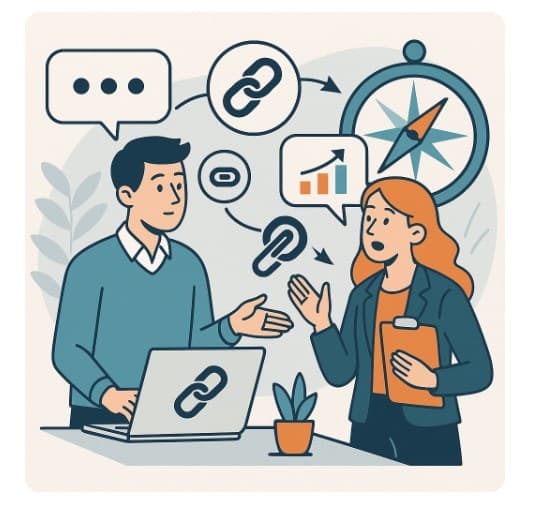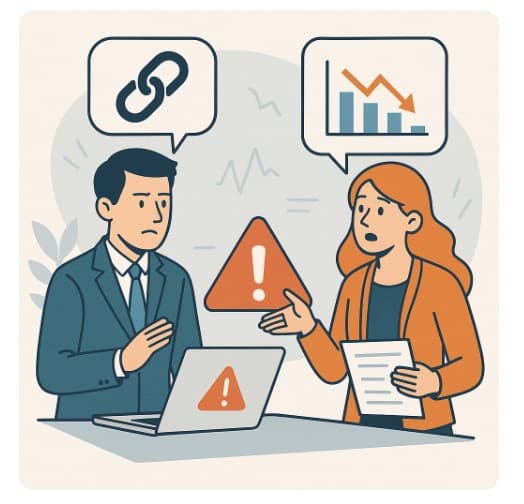It’s the middle of the month, and your invoice from the link building agency has just been paid. But then a quiet doubt creeps in.
What exactly is happening for that investment? Are there emails being sent? Pitches being written? Or is your project sitting in a queue? This feeling of frustration of paying for a process you can’t see. It’s the most common crack in agency-client relationships.
The truth is, effective link building services are largely invisible.
It happens in inboxes, on publisher calls, and in content drafts. You never see the ninety percent of outreach that gets no reply. This is why communication isn’t just a nice-to-have; it’s the entire foundation. It is the single window you have into the value being created, making it the most critical factor in the partnership, far beyond any single link.

Beyond the Report – Communication as Your Strategic Compass
A monthly report tells you what happened.
It’s a rearview mirror look at last month’s results. A strong agency relationship provides its greatest value by guiding what happens next.
The actual work happens between reports.
That steering happens through ongoing dialogue. The real strategy is refined in the conversations between reports—the quick check-in call, the email update on a promising lead, the discussion about shifting focus to a new industry niche.
This continuous conversation is where alignment happens.
It’s where an agency can say, “The outreach for finance sites is slow, but we’re seeing more traction in the fintech startup space. Should we pivot?” That simple update transforms the relationship. It stops being a transactional service and starts being a collaborative partnership.
The agency acts as your guide, but even the best guide needs feedback on the path. Your input on what feels right, what targets matter most, and what messaging resonates is the data they need to navigate effectively. Without that dialogue, you’re just hoping they’re heading in the right direction.
The Trust Deficit – What Happens When Communication Fails
When communication breaks down, the relationship doesn’t just stall, it actively corrodes. The client is left filling the silence with their own assumptions, which are rarely positive. This vacuum creates tangible anxiety. You start second-guessing the investment, wondering if the agency has forgotten about you, or if the entire strategy is flawed. That “what am I paying for?” feeling becomes a constant background noise, undermining the entire partnership.
It’s a cruel irony that an agency could be doing excellent work (securing thoughtful placements, navigating complex negotiations) but without communication, their effort is invisible.
Silence breeds suspicion. A week without an update feels like a month. A missed email can be misinterpreted as a lack of progress, even if the team is deeply engaged in productive work. The client’s perception becomes their reality, and that reality is one of doubt.
Contrast this with the security of proactive communication. A simple Monday morning email stating, “No major placements to report this week, but we have five active conversations with publishers and are refining our pitch for the tech sites,” completely changes the dynamic. It demonstrates activity and ownership.
It changes quiet periods from a cause for concern into understood phases of activity. This openness creates a reserve of goodwill. When a problem eventually occurs, it feels like a single event, not a pattern of failure.
The Anatomy of Effective Agency Communication
Telling someone to “communicate better” is vague advice. Good communication depends on its substance and purpose. It follows a clear set of principles.
The first is proactivity.
The agency should own the communication rhythm. They should be the ones initiating updates, especially when problems arise. A message about a delay or a rejected pitch, delivered early, builds more trust than a perfect report delivered late. It shows respect for the client’s stake in the project.
Next is clarity, not jargon.
Strong communication turns technical SEO terms into plain language. For example, instead of “orchestrating a synergistic content amplification strategy,” they might say, “we’re getting your article featured on relevant blogs.” This makes the work clear and understandable.
Setting realistic goals is fundamental.
A reliable agency discusses outcomes openly. They would rather under-promise and over-deliver. They talk about the process, including its slow parts. This clarity stops misunderstandings before they start.
The agency also needs to listen.
They should value your input as much as their own. Your knowledge of your business helps steer the campaign. This back-and-forth proves the work is a joint effort.

Final Thoughts
Good link building is a collaborative project, not an off-the-shelf product. The partnership’s health matters more than any single metric. The results you get depend entirely on the quality of that working relationship.
The best agencies grasp this completely. Their focus extends beyond securing links to maintaining a responsive and clear partnership. The ideal outcome is a client who always feels aware and involved in the progress.
This is the standard for a true collaboration, an approach where clear dialogue is treated as a fundamental deliverable, much like the philosophy at Linkbuilding.services that prioritizes client alignment and open communication as the bedrock of every campaign.

